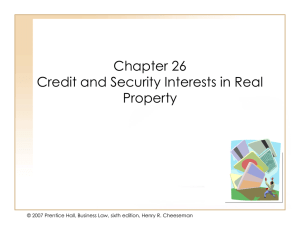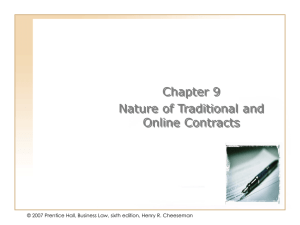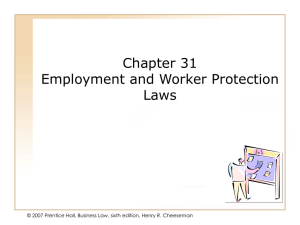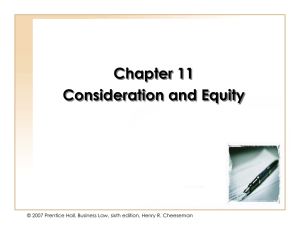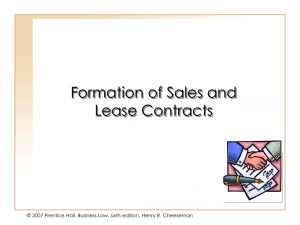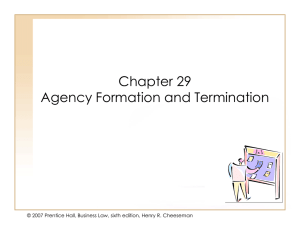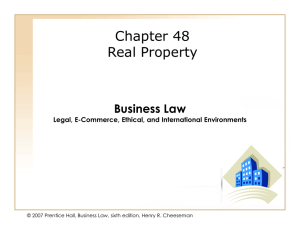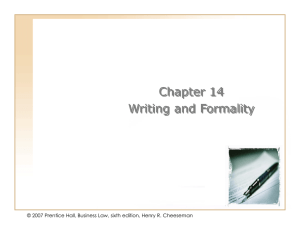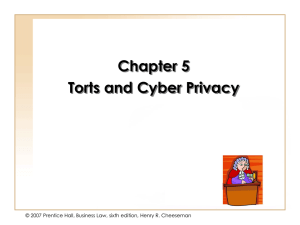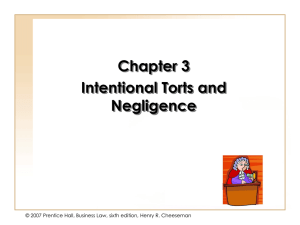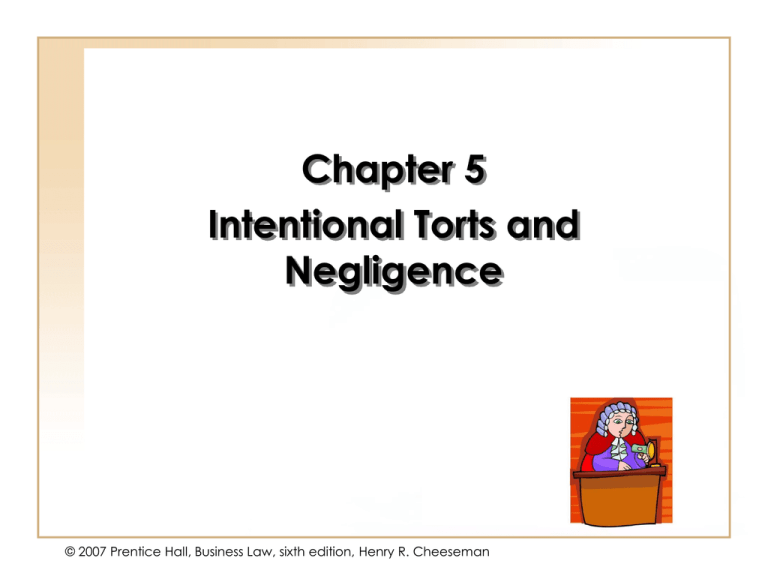
Chapter 5
Intentional Torts and
Negligence
© 2007 Prentice Hall, Business Law, sixth edition, Henry R. Cheeseman
Copyright © 2004 by Prentice-Hall. All rights reserved.
Introduction
• Tort is the French word
for a “wrong.”
• Tort law protects a
variety of injuries and
provides remedies for
them.
© 2006 Prentice Hall, Business Law, sixth edition, Henry R. Cheeseman
4-2
Introduction (continued)
• Under tort law, an
injured party can bring a
civil lawsuit to seek
compensation for a
wrong done to the party
or the party’s property.
© 2006 Prentice Hall, Business Law, sixth edition, Henry R. Cheeseman
4-3
Introduction (continued)
• Tort damages are
monetary damages that
are sought from the
offending party.
• They are intended to
compensate the injured
party for the injury
suffered.
© 2006 Prentice Hall, Business Law, sixth edition, Henry R. Cheeseman
4-4
Tort law imposes a duty on
persons and business agents
not to intentionally or
negligently injure others in
society.
© 2006 Prentice Hall, Business Law, sixth edition, Henry R. Cheeseman
4-5
Types of Torts
Intentional Torts
Unintentional Torts
(Negligence)
Strict Liability Torts
© 2006 Prentice Hall, Business Law, sixth edition, Henry R. Cheeseman
4-6
Intentional Torts Against
Persons
• The law protects a person
from unauthorized
touching, restraint, or other
contact.
• The law also protects a
person’s reputation and
privacy.
• Violations of these rights
are actionable as torts.
© 2006 Prentice Hall, Business Law, sixth edition, Henry R. Cheeseman
4-7
Intentional Torts Against Persons (continued)
• Misappropriation of the
Right to Publicity
– An attempt by another
person to appropriate a
living person’s name or
identity for commercial
purposes.
– Also known as the tort of
appropriation.
© 2006 Prentice Hall, Business Law, sixth edition, Henry R. Cheeseman
4-8
Intentional Torts Against Persons (continued)
• Defamation of Character
– False statement(s) made by
one person about another.
The plaintiff must prove that:
• The defendant made an an
untrue statement of fact
about the plaintiff; and
• The statement was
intentionally or accidentally
published to a third party.
© 2006 Prentice Hall, Business Law, sixth edition, Henry R. Cheeseman
4-9
Intentional Torts Against Persons (continued)
• Defamation of Character
(continued)
– Slander – oral defamation of
character.
– Libel – a false statement that
appears in a letter,
newspaper, magazine,
book, photo, video, etc.
© 2006 Prentice Hall, Business Law, sixth edition, Henry R. Cheeseman
4 - 10
Intentional Torts Against Persons (continued)
• Disparagement
– Untrue statement made
about products, services,
property, or reputation of a
business
– Also called product
disparagement, trade libel,
or slander of title
© 2006 Prentice Hall, Business Law, sixth edition, Henry R. Cheeseman
4 - 11
Intentional Torts Against
Property
• There are two general
categories of property:
– Real Property
• land and anything permanently
attached to that land.
– Personal Property
• things that are movable.
–
–
–
–
Automobiles
Books
Clothes
Pets
© 2006 Prentice Hall, Business Law, sixth edition, Henry R. Cheeseman
4 - 12
Intentional Torts Against Property (continued)
• Trespass to Land
– A tort that interferes with an
owner’s right to exclusive
possession of land.
– Unauthorized use of another
person’s property
© 2006 Prentice Hall, Business Law, sixth edition, Henry R. Cheeseman
4 - 13
Intentional Torts Against Property (continued)
• Trespass to and
Conversion of Personal
Property
– Tort of trespass occurs:
• Whenever one person injures
another person’s personal
property
• When one interferes with a
person’s enjoyment of his or her
personal property.
© 2006 Prentice Hall, Business Law, sixth edition, Henry R. Cheeseman
4 - 14
Intentional Torts Against Property (continued)
• Trespass to and
Conversion of Personal
Property
– A tort that deprives a true
owner of the use and
enjoyment of his or her
personal property by:
• Taking over such property;
and
• Exercising ownership rights
over it.
© 2006 Prentice Hall, Business Law, sixth edition, Henry R. Cheeseman
4 - 15
Unintentional Torts (Negligence)
• Unintentional Tort
– A doctrine that says a person
is liable for harm that is the
foreseeable consequence of
his or her actions.
© 2006 Prentice Hall, Business Law, sixth edition, Henry R. Cheeseman
4 - 16
Unintentional Torts (Negligence)
(continued)
• Negligence
– Negligence is the omission to
do something which a
reasonable man would do,
or something which a
prudent and reasonable
man would not do.
© 2006 Prentice Hall, Business Law, sixth edition, Henry R. Cheeseman
4 - 17
Unintentional Torts (Negligence)
(continued)
To be successful in a
negligence lawsuit, the
plaintiff must prove that:
1. The defendant owed a
duty of care to the plaintiff
2. The defendant breached
the duty of care
3. The plaintiff suffered injury
4. The defendant’s negligent
act caused the plaintiff’s
injury
© 2006 Prentice Hall, Business Law, sixth edition, Henry R. Cheeseman
4 - 18
Special Negligence Doctrines
(continued)
• Professional Malpractice
– The liability of a professional
who breaches his or her duty
of ordinary care.
– Reasonable professional
standard
• Medical malpractice
• Legal malpractice
• Accounting malpractice
© 2006 Prentice Hall, Business Law, sixth edition, Henry R. Cheeseman
4 - 19
Special Negligence Doctrines
(continued)
• Negligent Infliction of
Emotional Distress
– A tort that permits a person
to recover for emotional
distress caused by the
defendant’s negligent
conduct.
© 2006 Prentice Hall, Business Law, sixth edition, Henry R. Cheeseman
4 - 20
Strict Liability
• Strict liability is liability
without fault.
• A participant in a covered
activity will be held liable
for any injuries caused by
the activity even if he or
she was not negligent.
© 2006 Prentice Hall, Business Law, sixth edition, Henry R. Cheeseman
4 - 21
Strict Liability (continued)
This doctrine holds that:
1.
There are certain activities
that can place the public
at risk of injury even if
reasonable care is taken;
and
2.
The public should have
some means of
compensation if such injury
occurs.
© 2006 Prentice Hall, Business Law, sixth edition, Henry R. Cheeseman
4 - 22
Defenses against Negligence
• Assumption of Risk:
Here the injured party engages in
a risky behavior after being told
that the behavior is risky.
© 2006 Prentice Hall, Business Law, sixth edition, Henry R. Cheeseman
4 - 23

